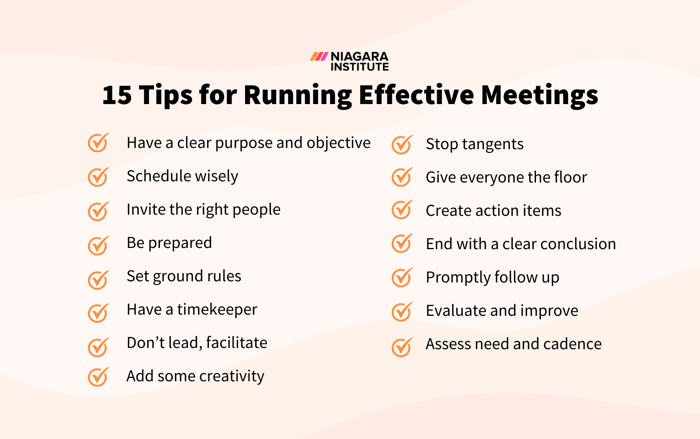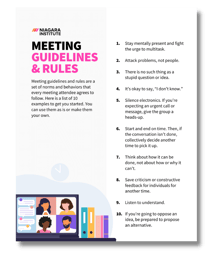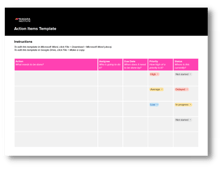6 min read
7 Free Management Meeting Templates and Tools
Whether it’s a monthly management meeting, an annual leadership summit, or an executive offsite, these meetings can become predictable and stale over...
.png)
We’ve all been there. Attending meetings where the leader drones on, a few people monopolize the conversation, and nothing is actually accomplished. You find yourself looking at the clock, seeing your inbox pile up, and wishing you were anywhere but here.
Ineffective meetings are a serious time sink and, according to an Otter.ai report, costly. They uncovered that a company with over 100 employees could save almost $2.5 million annually by eliminating pointless meetings.
It doesn’t have to be this way. When you’re the leader, you have the opportunity to run effective meetings. The kind of meeting attendees actually want to join, where problems are solved, decisions are made, and attendees leave feeling energized and motivated.
To help you, we’ve compiled 15 tips for running effective meetings. These are actionable, easy-to-implement tips that will help you lead the kind of meeting you’ve always wanted to attend.

The foundation of an effective meeting is a clear purpose and objective. You need to be able to answer the question, “What do I want to achieve by the end of the meeting?” One of the most common complaints about meetings is not having a clear purpose. To overcome this, ensure your purpose and objective for the meeting are crystal clear and share them in your invite email and agenda.
While you may think Monday mornings are the perfect time to host a meeting to get priorities and projects aligned for the week ahead, research suggests otherwise. It was uncovered the worst time to schedule a meeting is Monday morning. Conversely, it was found the optimal time for a meeting is Tuesday at 2:30 PM. While you may have time zones and other commitments to contend with, it is essential to choose a time that works for most attendee's schedules so they can be fully engaged.
How often have you been included in a meeting, only to wonder, “Why am I even here?” It’s a common practice to include way more attendees than what is actually necessary. Be critical of your invite list and only invite individuals who are essential to the discussion.
.png?width=220&height=259&name=Meeting%20Agenda%20Template%20-%20Niagara%20Institute%20(1).png) What you do before a meeting can differentiate between running an effective or ineffective meeting. As mentioned previously, having a clear objective, scheduling for the right time, and choosing the attendee list is critical. Now, all of that comes together in the first impression of your meeting - the meeting agenda. Your agenda should be sent at least 48 hours in advance and include the objectives of the meeting, the topics to be covered, as well as the corresponding owners, and the time allotment for each topic. We’ve made it easy to prepare for an effective meeting with the meeting agenda template.
What you do before a meeting can differentiate between running an effective or ineffective meeting. As mentioned previously, having a clear objective, scheduling for the right time, and choosing the attendee list is critical. Now, all of that comes together in the first impression of your meeting - the meeting agenda. Your agenda should be sent at least 48 hours in advance and include the objectives of the meeting, the topics to be covered, as well as the corresponding owners, and the time allotment for each topic. We’ve made it easy to prepare for an effective meeting with the meeting agenda template.
 Creating guardrails and behavioral expectations can help ensure your meeting results in spirited, productive discussion and debate. Ground rules establish what will and will not be accepted in your meeting. This helps create an environment where everyone feels comfortable voicing opinions, sharing ideas, and giving feedback without fearing ridicule or reprimand. We’ve created a list of 10 ground rules you may want to steal for your next meeting.
Creating guardrails and behavioral expectations can help ensure your meeting results in spirited, productive discussion and debate. Ground rules establish what will and will not be accepted in your meeting. This helps create an environment where everyone feels comfortable voicing opinions, sharing ideas, and giving feedback without fearing ridicule or reprimand. We’ve created a list of 10 ground rules you may want to steal for your next meeting.
Is there anything more frustrating than being in a meeting that never goes beyond the first agenda item? To run an effective meeting, it must stay on time, and to help you do so, you need to assign a timekeeper. Their role is to help you move through the agenda by periodically doing a time check and announcing when time is up on an agenda item.
It has been reported that Jeff Bezos advises that the leader, the one hosting the meeting, should always be the last to talk. Why? If the leader gives their opinion first, everyone will be influenced and follow what they say. When you’re leading the meeting, your role is facilitator. You’re there to move the agenda forward, remind attendees of the meeting objective, pose questions, and build links between ideas to facilitate collaboration, innovation, and problem-solving.
Over time, reoccurring team meetings can become stale and boring when the agenda is predictable. To overcome this, infuse some creativity into your meetings by incorporating different elements and activities. From having a guest speaker to getting aligned as a team, adding an activity that adds value can make your meetings more effective. Gain inspiration by checking out our 17 stealworthy meeting ideas.
In a survey of US employees, the number one challenge and annoyance of meetings is off-topic conversations and tangents. Tangents derail the critical items to be covered in the agenda, leaving attendees frustrated that their expectations for the meeting were not met. While it is important to make everyone feel heard, in these situations, as the meeting leader, you need to step in, record their topic, reiterate the agenda, and reinforce the outcome of the meeting to get the discussion back on track.
Over time, if meeting attendees feel like their voices are not being heard, that they’re interrupted when they speak, or uncomfortable sharing their input and ideas, they will eventually stop trying. An effective meeting is one where everyone has the opportunity to share their thought; that’s why they are there. So, as the meeting leader, you need to call on individuals and invite them to share. Identify attendees who haven’t had an opportunity to contribute and ask them for their input before moving to the next agenda item.
 Every meeting should include recording action items, which are meeting notes that clarify how, when, why, and by whom decisions were made and accountabilities assigned. They’re critical for providing clarity and ensuring the decisions made in the meeting are fulfilled back on the job. To make it simple, use our template for recording action items.
Every meeting should include recording action items, which are meeting notes that clarify how, when, why, and by whom decisions were made and accountabilities assigned. They’re critical for providing clarity and ensuring the decisions made in the meeting are fulfilled back on the job. To make it simple, use our template for recording action items.
The best way to end a meeting is by doing a verbal summary of the action items and accountabilities. Paul Axtell, in his Harvard Business Review article, suggests following your summary, you end by asking, “Is everyone OK with where we ended up?” because it “will surface questions or concerns so they can be resolved as soon as possible.” From there, conclude by expressing gratitude for everyone’s time and focus.
Within 24 hours of the meeting, send a brief message to all meeting attendees. Thank them for their time, summarize the decisions made and who is responsible for what going forward. Attach the action items to the email to provide more detail. The email reinforces each attendee's accountabilities, clears up any confusion, and acts as a written document where no one can claim they didn’t know what they were responsible for.
Building in the habit of continually assessing and optimizing your meetings will ensure you continue to run effective meetings. Periodically, solicit your attendee's feedback by sending out a meeting survey, like the one we’ve put together. In it, you’ll find questions you should ask, a template, and step-by-step guidance for creating an online survey.
Recurring meetings are notorious for becoming a time sink. Periodically evaluate if the goal has changed, if the frequency is still needed, or if the meeting is no longer required. Often, meetings occur because we get stuck in routines and don’t critically evaluate if it is still a good use of time.
.png)
6 min read
Whether it’s a monthly management meeting, an annual leadership summit, or an executive offsite, these meetings can become predictable and stale over...
.png)
4 min read
When it comes to how to run an effective staff meeting, there is one thing attendees want leaders to do, and according to research, that is to share...

8 min read
Leading a new project, forming a new team, or taking over an existing one can be exciting and daunting, and the kickoff meeting is the first...